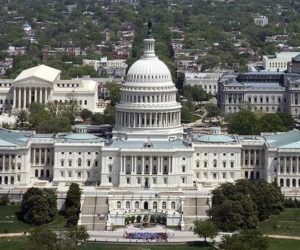The U.S. is facing massive structural unemployment – possibly for years to come. We can use a few but not all the ideas from the past because the world, and our nation’s private sector and Federal government, are significantly different from the 1930’s.
THE DISMAL NUMBERS
The past decade was remarkable for its miserable job growth and generally stagnant wages, even though the total U.S. population increased by over 20 million. Total 2009 workforce numbers for the private-sector economy and for all levels of government service are almost the same as they were in 1999. We can’t afford to have another stagnant decade that could be worse than the last. We are starting this new decade with high unemployment, mounting personal and business bankruptcies, massive residential and commercial real estate turmoil with steadily growing foreclosures, our public finances at the Federal and State levels completely unbalanced, and strong global competition from nations with far fewer domestic problems.
We have a steadily rising official unemployment rate of 10.2% and the unofficial under-employment and unemployment rate is at least 18%. We have more than 25 million people out of work, working reduced hours, part-time, as temporary independent contractors, or they have involuntarily gone back to school or are now staying at home taking care of kids and endlessly cruising job boards. This period of large unemployment resembles the 1930’s in sheer numbers but the origins are rather different. It has hit those over 45 particularly hard even though they have many skills and job experience. Simultaneously it has decimated the job prospects of many between 18 and 30 who might have college educations but limited prior job experience.
If arguably the March 2009 Stimulus Package has saved or created about 1.5 million jobs, at best it might save or create around 3 million more by the time it runs out of authorized funds at the end of 2011. Taking those numbers positively, they are still woefully inadequate in light of the need, and viewed suspiciously, they are almost irrelevant.
Much of the Stimulus money went to the States to cover massive budget shortfalls, so that is where we likely can find the “saved” jobs calculations. Another large chunk of Stimulus money went for income preservation in extending middle-class tax cuts, unemployment benefits, food stamps and Medicaid coverage. Infrastructure spending is just coming on line and will continue through 2011 but we can endlessly debate “shovel-ready” projects and our long-term infrastructure needs that have yet to be fully addressed.
This country needs to create at least 100,000 new jobs a month just to keep up with population growth. Economists in government, academia and the private sector anticipate we will be shedding more jobs for the next year or two. Massive government programs won’t solve this huge dilemma but several targeted public-private partnerships might hold more promise.
HISTORY OF THE CCC
There is a growing chorus calling for large-scale direct Federal programs for job creation, such as bringing back the Civilian Conservation Corp (CCC). Unfortunately they won’t work as they did back in the 1930’s because our entire economy has changed drastically since then. However, a small, targeted forestry and land management internship program could be a worthwhile part of a much larger effort that works directly with the private sector to create more jobs for the future.
PBS stations recently broadcast a very informative documentary about the original CCC. This was a national effort to employ millions of men in every state, principally working in public parks, forests, federal protected areas, wetlands, and other rural areas planting trees, building paths, dams, and accommodations in National Parks, and performing other related conservation and environmental activities. The pay was very low (about $25 a week per person) and the living conditions were minimalist as they were housed in Military-style barracks and tents. The U.S. was so desperately poor in the 1930’s that millions of young men flocked to this program. It was disbanded in 1942 at the start of World War II.
The PBS documentary showed battalions of universally thinner men than today working happily outdoors with shovels, pitchforks, wheelbarrows, and some modest mechanized construction equipment. They built thousands of small bridges, dams, new hiking trains, camp shelters, and new tourist lodges with stone, wood and other natural materials in our Nation’s parks and forests. The work was labor intensive and those who worked for the CCC had very limited educations or job skills. The CCC also provided literacy classes and basic job training during the evenings.
The men of the CCC were generally single, young and childless – and did I mention much thinner? If they had children, they were cared for by a stay-at-home spouse while they were shipped to far-off camps on a vast national network of inexpensive passenger trains that no longer exists. CCC men sent most of their earnings back to parents so they could survive before the days of unemployment benefits, food stamps and Medicare.
The men of the CCC were being prepared for the private sector jobs available at that time. They had to develop physically and mentally to do work in heavy manufacturing, construction and warehousing. The CCC was also a perfect training ground for the Military that eventually swallowed up most of them in 1942 for the War Effort. When they returned from the War, the 1950’s and 60‘s offered plenty of manufacturing, construction and warehousing jobs, plus the GI Bill to go to college to qualify for emerging jobs in the sciences and technology, and for new management positions.
CHANGED AMERICA
Why won’t a huge CCC work today? We can all acknowledge that our national parks and federal forests, plus many other state-owned and local city parks have been neglected for many years. We need to make some serious financial commitments to them but they won’t need millions of people digging with shovels to fix them. The most labor-intensive activity is the hand-planting of tree seedlings – which is not even the largest priority in our national park system today. In addition, our Federal and State Governments are much larger today so it takes much longer to get things organized with expansive bureaucracies.
Over the past 2 decades, our economy shifted the majority of our manufacturing facilities and labor-intensive work overseas to low-wage and low-cost countries, or to the dustbin of history through mechanization, computerization, and the use of robots. We will not need millions of young men to liberate half the world in a massive Military endeavor. Our country is financially strapped to maintain even its current military size, foreign bases, and large combat operations in Iraq and Afghanistan. Many of today’s job openings are in healthcare, renewable energy, basic accounting, computer network administration, public education, and other positions that deal with people and are located in offices.
It is rather unlikely we can get a large number of unemployed people to move to the wilderness or to live in camps outside our cities – unless things get far worse in our economy. We would likely have to house them in local motels at 2 to a room rather than building portable military-style camps. Much of the physical work performed during the 1930’s has long since been mechanized. Heavy physical labor and daily exercise might be good for many obese Americans but realistically speaking, there are few manufacturing or construction jobs left or in the future with the private sector. Many of today’s younger unemployed have families and they are often the sole parent or provider – so what are we going to do with their children?
TARGETED INTERNSHIPS IN FORESTRY AND LAND MANAGEMENT
A new Targeted Internship Program (TIP) could help from 1 to 2 million people develop new skills in forestry, land management, energy conservation, urban parks, and general environmental planning. However the program should be designed for the total number of private sector and government jobs that will be needed in these areas over the next decade.
The Federal Government, contracting through several regional private-sector management and job placement companies, would directly finance the employment of between 1 and 2 million people who enjoy working outdoors, who are interested in various land management issues, and who want to use the program as a low-paid internship. Many interns might not be assigned to work outdoors in National Parks but rather they would be placed in various Federal and State bureaucracies or with private sector companies for 1 or 2 years until the could be permanently employed outside the program.
If the interns are paid the same as Army Privates (around $17,000 a year) the total program would likely run about $40 to $80 billion over a 2 to 4 year period. It would take about 6 months to ramp up this multi-faceted program provided the private sector were given the principal task of actually allocating interns to governmental entities and private sector employers.
OTHER IDEAS FOR JOB CREATION
Unfortunately this TIP in forestry and land management would help less than 10% of the total unemployed in the U.S. so we must promptly pursue other job-creation ideas to fully address our larger national needs. Our efforts should focus on small business creation and its expansion as this sector has been, is, and will be the bedrock of the U.S. free enterprise system.
This post is not designed to denigrate all types of direct governmental job creation, or public sector employment. But most governmental spending, and the type that has the largest multiplier effect on the entire economy, is through contracts with private sector companies that actually perform the assigned tasks and build the needed infrastructure.
Many of those longer-term infrastructure projects are certainly worth supporting. However they are separate from the urgent need to restart our nation’s stagnant private sector economy, overall consumer confidence, and promptly reduce systemic unemployment in the U.S. Unfortunately, our dysfunctional financial and banking sector will not be of much help to the rest of the economy for many years to come.
Smaller private enterprises are far more capable of quickly responding to public stimulus money than are large corporations and governmental bureaucracies. Jobs will be created as the private sector expands but only if we creatively and forcefully target small business expansion. These other proposals will be addressed in my next TMV post.
Marc Pascal
















